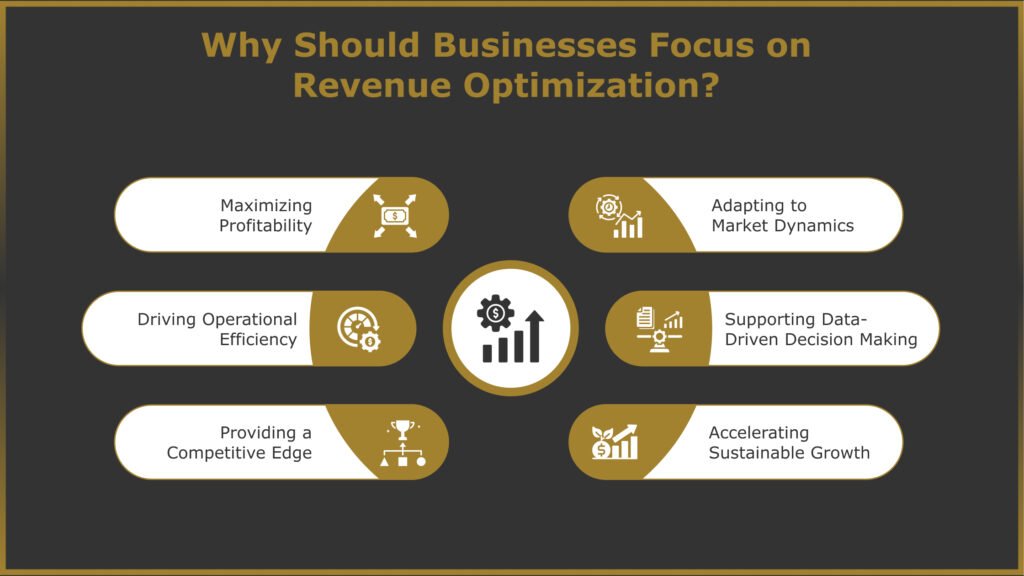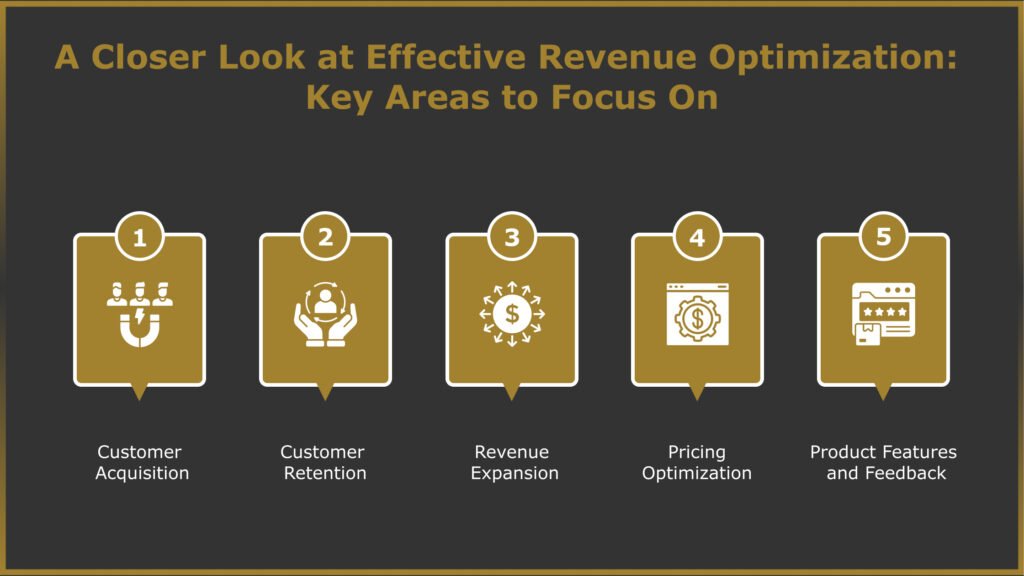Every business, regardless of its size or industry, shares a common goal: generating more revenue while controlling costs. But achieving this isn’t just about working harder or selling more. It’s about working smarter—improving your existing processes, pricing strategies, and customer relationships. That’s where revenue optimization comes in.
Revenue optimization offers a structured way to evaluate existing revenue streams, identify inefficiencies, and implement changes that deliver measurable results. It’s a data-driven, strategic approach that prioritizes value over volume.
This focus has driven significant growth in the global revenue management market, which is projected to reach $22 billion by the end of 2024.
What is Revenue Optimization?
Revenue optimization maximizes a business’s revenue potential by analyzing and improving pricing strategies, operational efficiencies, and customer interactions. It creates value by aligning revenue-generating activities with organizational goals, ensuring that every opportunity contributes to profitability.
The Important Elements of Revenue Optimization
- Pricing Strategy: Setting the right price for products or services based on market demand, competition, and customer willingness to pay.
- Customer Segmentation: Identifying and targeting different customer groups with tailored offers or pricing models.
- Operational Alignment: Streamlining processes to reduce costs, improve efficiency, and enhance the customer experience.
- Forecasting and Analytics: Using data to predict trends, adjust strategies, and capitalize on opportunities.
Why Should Businesses Focus on Revenue Optimization?

Here are some of the reasons your organization should prioritize revenue optimization:
1. Maximizing Profitability
Revenue optimization helps businesses fine-tune their pricing, sales, and customer engagement strategies to ensure every transaction contributes to the bottom line. For instance, implementing dynamic pricing models or targeting high-value customer segments can significantly enhance profit margins without increasing operational costs. Businesses that use a dynamic pricing strategy to guide see an average 5-10% increase in revenue.
2. Driving Operational Efficiency
Businesses can identify inefficiencies in their processes by analyzing revenue streams. Streamlined operations reduce costs and improve customer experiences. For example, a SaaS company might use automation to reduce onboarding time, allowing sales teams to focus on high-priority clients. Companies that automate business processes can reduce operational costs from 25% to 40%.
3. Providing a Competitive Edge
Businesses that optimize their revenue streams in competitive markets can reinvest in growth opportunities, such as product innovation or market expansion. This creates a virtuous growth cycle, allowing them to stay ahead of competitors who might still rely on outdated methods.
4. Adapting to Market Dynamics
Revenue optimization equips businesses with the agility to respond to changing market conditions. For example:
- During an economic downturn, companies can use insights to adjust pricing or focus on retention to maintain revenue.
- In periods of high demand, businesses can capitalize on opportunities by upselling or cross-selling.
5. Supporting Data-Driven Decision Making
Effective revenue optimization is built on data. By utilizing analytics tools, businesses can gain actionable insights into customer behavior, pricing trends, and market demands. This enables informed decisions that reduce risks and improve outcomes.
6. Accelerating Sustainable Growth
Ultimately, revenue optimization provides a roadmap for scalable and sustainable growth. Instead of focusing solely on short-term gains, it ensures that strategies align with long-term business objectives, creating a foundation for lasting success.
A Closer Look at Effective Revenue Optimization: Key Areas to Focus On

Before discussing specific revenue optimization strategies, it’s important to understand your current revenue streams. Evaluate your sales, marketing, and customer service efforts to pinpoint areas for improvement. Your focus might range from increasing customer engagement to exploring untapped markets or refining your pricing approach.
Here are steps to help you optimize critical areas of your revenue:
1. Customer Acquisition
Acquiring new customers is the foundation of revenue optimization, but it’s not just about quantity. The focus should be attracting high-quality customers who value your offerings and contribute to long-term growth.
Customer Segmentation: Divide your audience into groups based on behavior, needs, or demographics. Tailor your marketing messages to resonate with each group. For example, if you’re selling fitness equipment, create separate campaigns for daily gym-goers and busy professionals.
Focus on Profitable Channels: Invest in channels that attract loyal, high-spending customers. For instance, if your social media campaigns generate better returns than other channels, allocate more resources to them.
Track Key Metrics: Monitor metrics like customer acquisition cost (CAC) and campaign effectiveness to identify which strategies yield the best results.
2. Customer Retention
Retention is as necessary as acquisition, as retaining existing customers is significantly more cost-effective. It’s about promoting loyalty and encouraging repeat business by building solid relationships. Additionally, you have a 60-70% more chance of pitching and selling your products to existing customers than new ones.
Build Long-Term Relationships: To keep customers engaged, offer consistent quality, excellent customer service, and value-driven programs like discounts or loyalty incentives.
Improve Customer Satisfaction: Ask for feedback regularly and act on it to improve your offerings. Customers who feel heard are more likely to remain loyal.
Track Retention Metrics: Analyze attrition rates and develop strategies to minimize them. For instance, personalized email campaigns or proactive customer support can help improve retention.
3. Revenue Expansion
Expansion focuses on increasing the revenue potential of your existing customers. This can be achieved by upselling, cross-selling, or offering additional value through premium options.
Bundle Offers: Create packages that combine related products or services at a better value.
Introduce Premium Options: Offer advanced versions of your products or services to appeal to high-value customers.
Use Incentives: Loyalty programs, tiered pricing, or referral benefits encourage customers to spend more.
4. Pricing Optimization
Pricing is a critical lever for revenue growth. A thoughtfully planned pricing strategy balances customer expectations, market conditions, and profitability.
Market Analysis: Understand how your competitors price similar products and align your strategy accordingly.
Value-Based Pricing: Set prices based on customers’ perceived value of your offering rather than just production costs.
Review and Adjust: Regularly revisit your pricing strategy to reflect market conditions or customer preference changes.
5. Product Features and Feedback
Your product or service is central to revenue generation. Ensuring it evolves with customer expectations is essential for sustained growth.
Monitor Feedback: Regularly collect customer feedback to identify areas for improvement. Use surveys, reviews, and behavioral data to guide decisions.
Iterate and Refine: Focus on improving existing features and adding new ones only when they add real value. Avoid feature bloat, as simplicity often enhances customer satisfaction.
Communicate Changes: Inform customers about updates and how they enhance their experience. Transparency fosters trust and loyalty.
The Role of a COO in Revenue Optimization
Here’s how the COO contributes to revenue optimization:
- Streamlining Operations for Efficiency: By refining internal operations, the COO reduces inefficiencies and cuts costs, focusing resources more effectively on revenue-driven areas.
- Implementing Data-Driven Strategies: The COO integrates data collection and analysis tools to track performance metrics, using insights to identify areas for improvement and guide decision-making.
- Coordinate Pricing Strategies: The COO adjusts pricing strategies to remain competitive and meet business goals by continually assessing market conditions and customer feedback.
- Supporting Customer Retention Initiatives: The COO improves customer experience and promotes loyalty through service enhancements, upselling, and repeat business to increase customer lifetime value (CLV).
- Driving Cost Optimization Without Sacrificing Quality: The COO ensures that reducing costs does not compromise the quality of products or services offered by optimizing supply chains and renegotiating vendor contracts.
- Monitoring and Adjusting Business Performance: The COO tracks key performance indicators (KPIs), making real-time adjustments to stay on track with revenue targets and ensure ongoing optimization efforts.
Maximize Your Business Potential with Outcomes COO – Let’s Drive Growth Together!

At Outcomes COO, we understand that every business faces unique challenges. Whether you’re looking to optimize operations, scale quickly, or streamline financial management, our tailored solutions can help. Our expert team provides strategic guidance and Fractional Leadership to businesses generating between $4M and $40M in revenue.
With services ranging from business strategy development to operational efficiency consulting and financial advisory, we work closely with you to implement solutions that lead to measurable results and long-term growth.
Take the first step towards optimizing your revenue today.
Learn how Outcomes COO can help you drive operational efficiency, align your leadership team, and confidently achieve your business goals. Let’s build the future of your business together!

